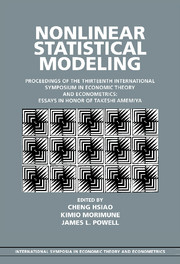 Nonlinear Statistical Modeling
Nonlinear Statistical Modeling Book contents
- Frontmatter
- Contents
- Series editor's introduction
- Editors' introduction
- Contributors
- 1 Local instrumental variables
- 2 Empirically relevant power comparisons for limited-dependent-variable models
- 3 Simulation estimation of polychotomous-choice sample selection models
- 4 A new approach to the attrition problem in longitudinal studies
- 5 Semiparametric estimation for left-censored duration models
- 6 Semiparametric estimation of censored selection models
- 7 Studentization in Edgeworth expansions for estimates of semiparametric index models
- 8 Nonparametric identification under response-based sampling
- 9 On selecting regression variables to maximize their significance
- 10 Using information on the moments of disturbances to increase the efficiency of estimation
- 11 Minimal conditions for weak convergence of the sample standardized spectral distribution function
- 12 Unit root tests for time series with a structural break when the break point is known
- 13 Power comparisons of the discontinuous trend unit root tests
- 14 On the simultaneous switching autoregressive model
- 15 Some econometrics of scarring
- 16 A censored switching regression approach to evaluating the effect of sunk costs and firm-level disequilibrium on export performance
- Curriculum vitae of Takeshi Amemiya
- Index
13 - Power comparisons of the discontinuous trend unit root tests
Published online by Cambridge University Press: 05 June 2012
- Frontmatter
- Contents
- Series editor's introduction
- Editors' introduction
- Contributors
- 1 Local instrumental variables
- 2 Empirically relevant power comparisons for limited-dependent-variable models
- 3 Simulation estimation of polychotomous-choice sample selection models
- 4 A new approach to the attrition problem in longitudinal studies
- 5 Semiparametric estimation for left-censored duration models
- 6 Semiparametric estimation of censored selection models
- 7 Studentization in Edgeworth expansions for estimates of semiparametric index models
- 8 Nonparametric identification under response-based sampling
- 9 On selecting regression variables to maximize their significance
- 10 Using information on the moments of disturbances to increase the efficiency of estimation
- 11 Minimal conditions for weak convergence of the sample standardized spectral distribution function
- 12 Unit root tests for time series with a structural break when the break point is known
- 13 Power comparisons of the discontinuous trend unit root tests
- 14 On the simultaneous switching autoregressive model
- 15 Some econometrics of scarring
- 16 A censored switching regression approach to evaluating the effect of sunk costs and firm-level disequilibrium on export performance
- Curriculum vitae of Takeshi Amemiya
- Index
Summary
Introduction
Perron (1989) developed unit root tests which allow for a break in the deterministic trend. The Perron test is asymptotically similar. Related tests have also been suggested by Schmidt and Phillips (1992), Oya and Toda (1998), Bhargava (1986, 1996), and Kiviet and Phillips (1992). In this chapter, we extend the Perron unit root tests to allow for multiple breaks in the trend and investigate both their asymptotic and finite sample properties.
Zivot and Andrews (1992) have studied the unit root test when the location of a break point is unknown. They used the t ratio associated with the lagged dependent variable to find the break point. However, the null distribution requires no break in the trend function. Vogelsang and Perron (1998) used the t ratio of the discontinuous trend variable to find the break point. Hatanaka and Yamada (1997) used the residual variance to find the break point, and extended the Zivot–Andrews test so that the null hypothesis allows a discontinuous trend. Break points resulting from these tests may conflict with common knowledge, since researchers have rough ideas on when the break actually happened. The Perron test may be applied by setting a wide break interval that possibly covers a break point through the use of shock dummy variables.
In Section 2 we propose a unified framework for the unit root tests that allow for multiple breaks in both the intercepts and trend coefficients as in the Perron C model, for multiple breaks in intercepts only as in the Perron A model, and for joined trend lines as in the Perron B model.
- Type
- Chapter
- Information
- Nonlinear Statistical ModelingProceedings of the Thirteenth International Symposium in Economic Theory and Econometrics: Essays in Honor of Takeshi Amemiya, pp. 349 - 362Publisher: Cambridge University PressPrint publication year: 2001


